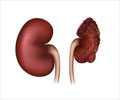Highlights
- Mycobacterium tuberculosis bacteria invade human macrophages and prevent them from programmed cell death.
- Scientists have found a method to release the bacteria and kill them by a lower concentration antibiotic.
- PPM1A (Protein Phosphatase, Mg2+/Mn2+-dependent 1A) enzyme is a central component of both the antiviral and antibacterial responses of macrophages.
- Inducing this enzyme provoked by M. tuberculosis ends the macrophage's ability to undergo both intrinsic and extrinsic apoptosis.
This strategy has been dubbed "release and kill," by Jim Sun, Ph.D., and colleagues, and if developed to clinical application, it could mean greatly shortened treatment periods for patients with tuberculosis, which now last at least six months.
Their preclinical findings show, for the first time, that drug-induced selective apoptosis of M. tuberculosis-infected macrophages is achievable. Furthermore, drug-induced apoptosis could also improve the adaptive immune response against the pathogen and potentiate vaccines.
Sun and colleagues in a previous study identified a macrophage enzyme called Protein Phosphatase, Mg2+/Mn2+-dependent 1A (PPM1A) as a central component of both the antiviral and antibacterial responses of macrophages. When M. tuberculosis infects macrophages, they found that it induced the upregulation of PPM1A, which in turn caused "immune paralysis" of the macrophages.
Specifically, the heightened PPM1A levels abrogated the ability of macrophages to send out an "alarm signal" (the efficient production of cytokines and chemokines) in response to pathogen-associated molecules like lipopolysaccharide, it blocked the rush to the "scene of the fire" (migration of macrophages in response to a chemotactic signal of infection from other cells), and it prevented the macrophage's ability to "put out the fire" (by impairing the macrophage's capacity to engulf, or phagocytose, bacteria, the first step in the normal defense against bacterial infections).
Apoptosis is a normal, daily event. Between 50 billion and 70 billion cells in an adult undergo apoptotic death every day. Intrinsic apoptosis responds to a signal of cell aging or dysfunction from the inside, and extrinsic apoptosis responds to a 'death signal' from outside the cell.
M. tuberculosis blocks these events, and when the bacteria are ready to exit the macrophage to disseminate, they induce necrosis, not apoptosis, of the cell, which evades stimulation of an immune reaction.
Reference
- Jim Sun et al., A 'release and kill' strategy may aid treatment of tuberculosis, Scientific Reports (2017).
Source-Medindia














